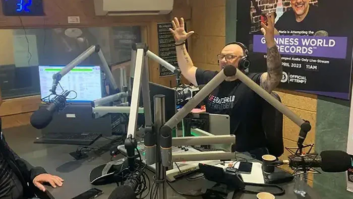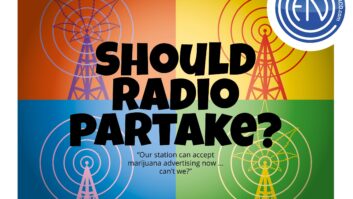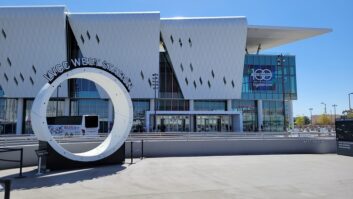Caption has been updated to identify Birgit Nilsson.
The author is director of syndication for WFMT Radio Network, which creates and distributes popular arts and culture audio programs. WFMT Radio Network is part of local station WFMT, which served as Terkel’s professional home for 45 years.
Many radio stations have troves of old archival tapes stashed on shelves or hidden in closets, quietly imploring the already too-busy staffs to give them a second life and to let them speak to the future.

Studs Terkel was known for interviewing both celebrities and everyday people. He is shown here, at right, interviewing Swedish soprano Birgit Nilsson around 1950.
Courtesy of the Chicago History Museum Radio, at its best, has an immediacy and clarity that allows a listener to travel back in time. The potential uses of radio archives are enormous and intriguing. With television or film, archival images immediately make us notice the difference: how people’s appearances or settings or gesture have changed over time and how camera technology has evolved.
Radio archives, on the other hand, have a timelessness that can put a listener right back in the presence of people long gone. Voices of decades gone are suddenly with us again, ghosts speaking directly from the past, with urgency and intimacy, as though they never left.
This power of audio to speak across time combined with new digital technologies and platforms that are just becoming available, whether smart phones or podcasts or transcription tools, make this a potential golden age for radio and other sound archives. Universities, foundations and inventive new non-profits are beginning to fund radio archive projects with greater enthusiasm. As a result, those old tapes on the shelves of radio stations can become the raw material to be used by teachers, journalists, historians, artists, museum curators and of course contemporary radio producers in ways that were hard to imagine a decade ago.
I am excited to share a few notes from our experience here in Chicago building Studs Terkel’s complete radio archive in recent years with the aim of helping other radio stations think about the potential for their own archives in new ways and, pragmatically, to share details on some of the resources we’ve been fortunate to discover along the way.
WFMT 98.7 and the WFMT Radio Network have the good fortune of being the broadcast home of legendary oral historian and radio host Studs Terkel for 45 years. He left behind a staggering archive of 5,600 radio programs, mostly on reel-to-reel, when he died at the age of 96 in 2008 (still fully charged, eagerly awaiting the results of that presidential election that happened four days after he died).
Studs expressed a strong desire that his audio archive might somehow be used in the future, a desire that our staff and other partners have embraced.
While the ultimate form of Studs’s radio archive is still evolving, we are eager to share a few ideas and technologies that we have discovered during the first few years of trial and error in the hopes that other radio stations pondering making their own archives more accessible can benefit from our experiences and perhaps even collaborate in years to come.
Fortunately, we are far from alone in making audio archive experiments: organizations such as WNYC, NPR, Pacifica Radio and especially the umbrella Radio Preservation Task Force, give us a bustling batch of friendly neighbors to confer with.
So here’s a brief history of how Studs’ giant radio archive has grown in recent years.
Three years ago, in the autumn of 2013, the WFMT Radio Network started a conversation with the Chicago History Museum (Studs had the foresight to move his tapes there when he retired in 1997 — he cared greatly about his archive) about finding creative ways to make the radio archive more accessible to the world. Since then, the WFMT Radio Network has come to specialize in producing and syndicating radio programs on the arts and culture to stations around the United States and, more and more, internationally.
What do you do with 5,600 Studs Terkel radio shows? We’re talking about shamelessly intellectual, stream-of-consciousness, against-the-grain of today’s overproduced media sound-bite parade, including voices of the celebrated (Martin Luther King, Bob Dylan, Simone de Beauvoir, Louis Armstrong and thousands more) and the non-celebrated working people, wrestling with big social issues and discovering new ways of thinking live, in-the-moment programming.
These programs are sometime meandering, always vivid and full of radio “mishaps” — cigarettes being lit against the mic, a sense of exuberance and lack of a safety net.
The archive also includes audio docs made in the field — South Africa, the Soviet Union, Italy, France, China, the Jim Crow South — masterfully curated music or poetry shows, chronicles of a blizzard or the public’s reaction to a new Picasso sculpture showcased in the heart of Chicago that was arranged by old Mayor Daley.
The saga of how Studs’ radio archive is being developed is too long to cover in full here, and the long-term plans are still taking shape. But it may be helpful to share a few aspects of what we’re doing so that others pondering ways to make use of your own radio archives could react to and consider them. We’re also open to trading notes and ideas.
FUNDING

Studs Terkel’s shows were nothing less than “shamelessly intellectual, stream-of-consciousness, against-the-grain” radio, the author writes.
Courtesy of the Chicago History Museum For any station contemplating taking the stash of old tapes and transforming them into a living, accessible audio archive, funding is obviously a key question. Ideally building an audio archive helps define a station, underscoring a station’s unique history and generating enthusiasm amongst donors, board members and other community partners. WFMT / the Radio Network were fortunate that general manager Steve Robinson and other leaders saw the value of Studs Terkel’s Radio Archive. Likewise, we benefited immensely from the fact that the Chicago History Museum was able to partner with the Library of Congress to digitize the reel-to-reel tapes on which almost all of Studs’s programs were stored, work valued at over $900,000, without which the idea of building an online digital archive would still only be a daydream.
Of course, not every archival radio collection will generate such outside technical support (Studs Terkel’s reputation and the range of people he interviewed makes his collection somewhat unique), other opportunities for funding exist. We were fortunate to receive a $60,000 planning grant from the National Endowment for the Humanities in the summer of 2014, and in January-February of 2016, we embarked on an ambitious Kickstarter campaign with a goal of $75,000. The Kickstarter was successful (raising $87,000) and also generating a bundle of very helpful press coverage about the archive (Time magazine, Rolling Stone, Slate, The Chicago Tribune, Brain Pickings and many other media-produced stories).
We could produce an entire article about the lessons, tribulations and benefits of running a Kickstarter to support a radio archive and are glad to share what we learned with others. For the time being, perhaps the most important idea we came away with was that the general public is seemingly most inspired to donate because they have reason to believe that young people/future generations will have opportunities to only listen to voices from the past but actively re-use audio in various creative and educational ways and also that donors are keen to come visit and learn about building an archive first hand (tours and visits to meet radio producers and archive staff were surprisingly popular and led to high level gifts to the Kickstarter). That said, as with all Crowdfunding, building an audience ahead of time is clearly key.
The long-term funding for the Studs Terkel Radio Archive continues to evolve and in the next year or two we intend to have a much greater understanding of the landscape of potential funding sources, not only in the United States but globally.
BUILDING THE FOUNDATION AND PARTNERSHIPS

Allison Schein, archive manager, and author Tony Macaluso, director of network syndication for the WFMT Radio Network.
Courtesy John F. Holmes While there are many aspects of the archive that might be of interest to RW readers, for the remainder of this article I will focus on sharing details on some partnerships and technical experiments that we’re undertaking that might be useable by other radio archives. Each of these has its own story, full of narrative twists and turns and fascinating people and anecdotes, and other information.
Thanks to the funding described above, we were able to hire a pair of trained archivists: Allison Schein who now oversees archive management for WFMT as a whole as well as the Studs Terkel Radio Archive and also Grace Radkins, our digital content librarian who has pioneered various ways of reusing and re-contextualizing audio content, many examples of which can be seen on our blog: http://studsterkel.wfmt.com/blog/.
One of the most important steps in laying the foundation for the project was to form a Studs Terkel Radio Archive Advisory Committee that includes people from various partner organizations who have an interest experimenting with how to use Studs’ audio. These include:
• The Great Books Foundation — They specialize in, among other things, creating marvelous educational curriculum, until now based on written content, but they’re eager to explore what it means to use audio.
• National Radio Preservation Task Force — Helping us connect with scholars and technical experts around the country.
• Illinois Humanities — Our local state humanities council organizes public events and helps us connect with long-term cultural programs.
• Chicago Collections — A new consortium of historic archives at various museums, libraries and universities.
• The Studs Terkel Center for Oral History at the Chicago History Museum
• The Black Metropolis Research Consortium — Studs was very much at the forefront of breaking down color barriers in music, culture and society in general.
• Lois Baum, Tony Judge, Sydney Lewis and Adrian Marin — A quartet of individuals who worked directly with Studs and who are managing the Studs Terkel Estate.
This committee has a critical mandate which is to meet and hash out a long-term vision for the archive plus evaluate and advise on key decisions. Part of developing that long-term plan has been to map out four main components of the archive:
1. The online collection itself, carefully organized, divided into 40+ categories to make it easy and fun to explore. Eventually we’ll have accurate transcripts (some are already done) so people can search within the programs, and all sorts of interesting tools, some being pioneered on Studs’ archive such as:
a. Hyperaud.io Pad — A browser-based remixing tool that allows for both video and audio manipulation by dragging and dropping selected elements of a program. Those who have access to a computer will be able to create remixed Studs Terkel programs reflecting their chosen vantage point. You can preview it at http://studsterkel.hyperaud.io/. We’re excited how this tool will engage millennials and extend Studs’ voice and influence, making him a part of conversations we’re having now on race, feminism, civil rights, and other relevant topics.
b. Trint — An online transcription editor for both audio and video that creates interactive transcripts, which can easily be shared and also ported over to Hyperaud.io for easy remixing. The highlighting function is important, for those who teach or need quick references points. Sign up now at https://beta.trint.com/beta-signup.
c. DigitalReLab / Starchive — An innovative back-end asset management system designed to organize our audio and seamlessly create derivatives, allowing for accessing and ingesting incoming material from various sources. See their video at http://digitalrelab.com/.
d. Vamonde — A location-based audio platform that pins specific audio to a location — in order to create an audio adventure that is downloaded via the Vamonde app (available in iOS only but Android coming soon). We are able to use this tool to bring Studs’ conversations to the neighborhoods in which he loved interviewing regular people. Students will also use this tool to interact with other Studs programs with their voices mixed in. To explore Chicago’s adventures go to www.vamonde.com.
e. Dominican University’s Library and Information Science Graduate School has worked closely to provide stellar interns and support on many levels.
f. Third Coast International Audio Festival has been a helpful friend — they made the Studs archive the subject of their annual ShortDocs competition this year, which meant hundreds of radio producers made short radio programs inspired by Studs.
2. Educational use: Helping schools create curriculum based on Studs’ audio, especially around themes and topics — for example, the Civil Rights and Labor Movements, Work or Community, especially those interviews where he talks to the everyday man, woman or youth.
3. Reuse material: Encouraging journalists, teachers, scholars, artists, radio producers and other media makers to get creative about repurposing it.
4. Take it Easy, But Take it: a weekly podcast/radio series, in which guest curators are invited to pick programs from the archive and create their own audio response/storytelling that connects Studs’ conversations or programs from the past with the contemporary world.
One of the first steps was to start encouraging other organizations to use material from the archive in order to test and demonstrate how Studs’ work could be relevant today.
Quite quickly organizations such as “This American Life,” “Radio Diaries,” “All Things Considered,” The Third Coast International Audio Festival, “Blank on Blank,” Radio France, the Poetry Foundation and many others have used material for radio shows, podcasts, films and audio competitions. And coming up in 2017: the BBC commissioned two hour-long documentaries based on Studs’ work from British audio company Falling Tree Productions, which will be heard globally on the BBC.
This year we also formed an extensive partnership with Chicago Public Library’s YOUMedia teen program and CPS — especially Curie Metropolitan High School, ChiArts and Gwendolyn Brooks College Preparatory Academy — in order to get teens to explore Studs’ audio and to create their own original work inspired by him. Work developed by the program, called New Voices on the Studs Terkel Radio Archive, can be seen at www.nvonstuds.com.
The curriculum created out of the pilot New Voices on Studs Terkel Radio Archive program is in its development with Chicago Public Library’s YOUmedia department, Chicago Public Schools and the Great Books Foundation. Our free unit plans will be made available nationally to teachers.
THE FUTURE
While the Studs Terkel Radio Archive is still in the early stages of what we hope will be a long and fruitful existence full of unanticipated uses, the past three years have opened our eyes to the varied possibilities. We know from talking to many of Studs‘s colleagues that he dearly hoped that his work would not only be listened in the future, but perhaps more poignantly, that it would also be used as raw materials for new work by others. During his 45 year career at WFMT, Studs himself frequently dug into his own archive to grab a bit of audio to play at the beginning of a newer interview. He delighted at the idea that the voice of Big Bill Broonzy or Simone be Beauvoir or Kurt Vonnegut might inspire fresh thoughts in some later guest or situate a conversation in a deeper historical context or sometimes just dazzle listeners with an unexpected connection. If the Studs Terkel Radio Archive can be a tool for young radio producers, teachers, theater directors, community organizers, musicians, investigative journalists or others, then Studs‘s work, and radio in general, become less trapped in the present moment and the cultural amnesia that comes from a lack of meaningful connection with the past.
So — in Studs’ immortal words — we encourage those in the radio world or other disciplines to “Take it easy, but take it!” and help us to explore the possibilities for this unique audio archive. Anyone wanting to exchange radio archive ideas or explore using audio in the archive for new projects is invited to get in touch with us at [email protected] or studsterkel.org.












